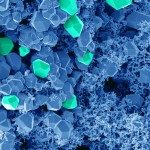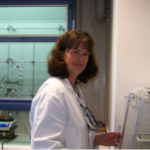About
NAD mimics as potential antibacterial agents
The NAD(P) biosynthesis pathways have attracted recent interest as a source of enzyme targets for the development of antimicrobial agents. Our own research focused on the structure-based development of inhibitors of NAD kinase from Gram-positive bacteria. This multidisciplinary program was supported by ANR grants (coll. with L. Assairi, Curie-Orsay; O. Dussurget, IP; G. Labesse, CBS Montpellier).
Nicotinamide adenosine dinucleotide kinases (NAD kinases) are essential and ubiquitous enzymes involved in the unique step of the biosynthesis of NADP from NAD. They catalyse the transfer of a phosphate group on the substrate NAD to produce NADP in the presence of both ATP and Mg2+. We selected the NADK from L. monocytogenes (LmNADK1) as a study target for inhibitor development. The X-ray structures of LmNADK1 in apo form and complex with its natural ligands, NAD and NADP, as well as two synthetic NAD mimics (AppA and DTA) were solved, providing the first refined structure of the active site and the first complex of an NAD kinase with a non-natural competitive inhibitor (DTA). Interestingly, the 3D structure of the di-adenosine derivative bound to LmNADK1 showed the perfect mimicry of adenosine with riboside-nicotinamide in the sub-site N (Poncet et al., 2007).
These results were used as the starting point for the design of original inhibitors following a fragment based approach (ANR-06-BLAN-0324). A focused chemical library around purine scaffolds was generated, including suitable linkers and functionalities for fragment growing and linking (Morelatto et al. 2014). X-ray crystallography was used to identify the ligands that fit into each site together with their binding modes. Once identified, their inhibitory potency was evaluated on purified recombinant LmNADK1. A second round of synthesis was done to optimize decorations on the purine scaffold. During this process, we discovered an unexpected chemical reactivity that allowed to bridge in situ two adenosine derivatives into an original ligand that fully occupied the active NAD site. This ligand and related molecules were synthesized and evaluated against two recombinant NAD kinases, LmNADK1 from L. monocytogenes and SaNADK from S. aureus. One compound showed inhibition of both enzymes and a promising bactericidal effect against S. aureus S25 strain (Gelin et al., 2012). We are currently working on improving the antibacterial efficiency of this new family of NAD mimics (Patent EP2471804) (ANR-11-EMMA-0019, ANAKIN).








